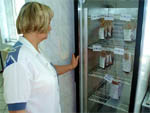Normal blood test results.

In the following article, we present some of the blood parameters, description and values considered correct for women (K) and men (M)
Urea nitrogen
Urea nitrogen testing is mainly used to assess kidney function.
Blood norm: 7.1-16.3 mmol/l (10-23 mg%)
Cholesterol
It is a sterol compound found in plasma in alpha- i beta-lipoproteinach, the concentration of which increases when consuming energy-rich foods, especially carbohydrates, influencing the risk of atherosclerosis. And yes – lowering cholesterol by 1% reduces the risk of coronary heart disease by 2%. LDL – that is, the fraction positively correlated with the incidence of coronary artery disease – as the level increases, so does the risk… Other risk factors – overweight, hypertension, diabetes, smoking, male gender, postmenopausal women, stress, sedentary lifestyle, they also have a great influence on laboratory research.
Rule: Some general recommendations are recognized
- do 200 mg% is considered to be correct
- from 200 mg% do 250 mg% – elevated
- above 250 mg% – incorrect
Glyerydy
Neutral fats are the main constituents of chylomicrons – protein compounds- fatty acids responsible for the transport of fats in the blood (simply from the gut to the liver). Hence, their increased concentration occurs mainly after meals.
Rule: Glyerydy (ok. 90% to trójglicerydy – TG) – their normal plasma concentration is within limits 30-300 mg% (sic!). On average it is in women 140(+-60) mg%, in men 170(+-100) mg%…
Lipoproteiny alfa-1 (high density – HDL)
They pose 17 – 30% lipoprotein, contain approx. 2% cholesterol. It is believed, that HDL is responsible for removing cholesterol from the vessel walls.
Lipoproteiny beta (low density – LDL)
They pose 48 – 75% lipoprotein, and contain approx. 50% cholesterol. LDL is the opposite of HDL, and LDL-cholesterol is a major risk factor for atherosclerosis.
Urea
Plasma urea depends on the amount of protein in the diet and the kidney's ability to handle it (urea) expulsion.
Rule: With a diet containing 1 g of protein / kg body weight (m.c.) blood urea nitrogen concentration is approx. 8.6 mmol/l (12 mg%). Protein consumption in the amount of approx. 2 g / kg bw causes an increase to approx. 14.2 mmol/l (20 mg%).
OB (Biernacki's reaction)
The depletion of blood cells in the serum depends on the physical and chemical properties of the blood. Determined after 1, and sometimes also and 2 hours
Rule: K do 12 mm, M do 8 mm (po 1 h)
HEMATOKRYT (Ht, HCT)
Volume ratio of erythrocytes to blood plasma, referred to as % the volume of blood cells in a certain volume of blood
Rule: K 37-47%, M 40-54%
HEMOGLOBIN (Hb, HGB)
The amount of blood dye that binds oxygen and carbon dioxide. Specified in grams per 100 ml [g%] or in millimoles per liter [mmol/l]
Rule:
K 6.82-9.31 mmol/l (11.0-15.0 g%)
M 7.45-10.55 mmol/l (12.0-17.0 g%)
ERYTROCYTY (Red blood cells – E, RBC)
Due to their shape and hemoglobin content, erythrocytes are used for gas exchange (the transfer of oxygen and carbon dioxide).
Standards:
K 4.8 +/- 0.8 T/l (4.8 +/- 0.8 M/ul)
M 5.4 +/- 0.8 T/l (5.4 +/- 0.8 M/ul)
Average volume in fl (MCV)
82 – 92
Average weight of Hb in pg (fmol) (MCH)
1.8 – 2.2 (27 – 31)
The mean concentration of Hb in % (mmol/l) (MCHC)
20 – 21 (32 – 34)
Thickness in um
1.7 – 2.5
Diameter in um
6.0 – 9.0
TROMBOCYTY (Platelets – T, PLT)
Platelets are involved in the process of hemostasis, blood clotting, and they also store and transport some amines (m. in. serotoninę, adrenaline)
Rule: 150 – 300 G/l (K/ul)
LEUCOCYTES (White blood cells – L, WBC)
White blood cells play a very important role in the body's defense mechanisms.
Rule: 4.0 – 10.0 G/l (K/ul)
There are several types of white blood cells in the peripheral blood. Their number is usually determined as a percentage (%) or in absolute terms (G/l).
1. neutrophilic granulocytes
- young characters("Young"): 0 – 1 % (0 – 0.1 G/l)
- rod-shaped forms ("Sticks"): 3 – 6 % (0.18 – 0.48 G/l)
- split characters (”podz”): 56 – 66 % (3.4 – 5.2 G/l)
2. granulocyty kwasochłonne (”kw”)
2 – 4 % (0.12 – 0.32 G/l)
3. basophils ("Again")
0 – 0.5 % (0.02 – 0.04 G/l)
4. lymphocytes (“lim”)
20 – 45 % (1.2 – 2.7 G/l)
5. monocyty ("Mono")
4 – 8 % (0.24 – 0.28 G/l)